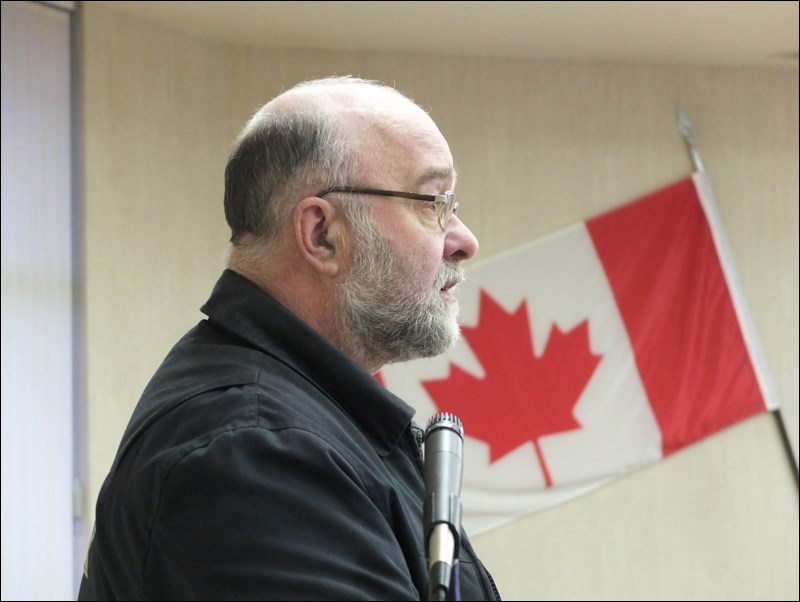Supporters outnumbered opponents but both sides were equally passionate as Flin Flon’s special services levy faced a make-or-break hearing last week.
The Manitoba Municipal Board held the hearing to glean public feedback on whether to extend the levy, designed to more evenly distributes civic taxes.
“There’s something wrong with our tax structure – it’s not working, it’s not right,” retiree Bruce Reid, a supporter of the levy, told the hearing.
Reid presented figures illustrating how without the levy, high-end homes carry a disproportionate share of the tax load.
At one point he engaged with levy opponent Skip Martin, telling him it costs the same amount to plow snow in front of his own house as it does in front of Martin’s.
Reid and 11 other presenters – half of them members of city council or city administration – spoke in favour of the levy while three people spoke against it.
The levy works by raising taxes on low-end homes and lowering taxes on high-end homes, though the latter homes are still charged far more money.
‘Poorest’
For Dennis Hydamaka, the levy raises concerns for “the poorest of the poor” who live in low-end homes in downtown Flin Flon.
Hydamaka said low-income people can be transient and that rent controls do not apply to landlords when they change tenants. He said one small downtown home that rented for a little over $400 a month in 2013 now rents for $850.
He said Flin Flon has a homelessness problem and few options for renters. He said he suspects the levy is a reason the Lord’s Bounty Food Bank, where he volunteers, has since last fall opened 51 new client files, each representing one or more clients.
Greg East, a landlord with multiple homes in Flin Flon, commended Hydamaka for his concern for low-income people but still came out in favour of the levy.
East wasn’t sure whether landlords are free to hike rents as high as they want between tenants. In fact they can do just that provided the apartment complex has three or fewer units (if it’s four or more units, the new rent cannot exceed the average rent charged for comparable units in the same complex).
East described the levy as a matter of fairness, saying some homeowners are paying as much as 1,500 per cent or more for the same services as other residents.
Daryl Chambers, who owns nine properties that range from low-end to high-end, wasn’t buying the fairness argument.
Chambers said his taxes went up $4,950 between 2013 and 2014, the year the levy was enacted on a trial basis.
“I fail to see [how] that seems to be fair,” said Chambers, adding that he plans to move away from Flin Flon because he can no longer afford to live here.
Mark Kolt, chief administrative officer for the city, framed the levy as a means of helping Flin Flon stay competitive with its neighbours for high-end housing construction.
“If we don’t do it, we can’t keep up,” he said, adding that the revenue implications of losing high-end homeowners are felt by all residents, including those in low-end homes.
Kolt cited figures showing a house worth $200,000 pays nearly $4,600 a year in taxes in Flin Flon without the levy in place. A house of the same value is charged just over $3,000 in Creighton and nearly $2,700 in Denare Beach.
If the levy is enacted in 2015, the Flin Flon homeowner would save $675 for a total tax bill that is $888 higher than in Creighton and $1,238 higher than in Denare.
On a $100,000 home, however, the levy brings the Flin Flon home to within $393 of Creighton and $293 of Denare Beach.
Construction
Another levy supporter, Tim Spencer, said he has watched as few high-end homes have been built in Flin Flon while many more have gone up in outlying jurisdictions.
Spencer believes the tax disparity is a big reason for that. He called the levy “a reasonable thing to do.”
Bill Hanson, a city councillor and owner of a low-end home, said his taxes have tripled over the years but he’s okay with that because he long paid only $249 annually for the same services as everybody else.
But one of Hanson’s former council colleagues, Skip Martin, wondered whether all owners of low-end homes are in a position to afford the increases.
Martin defended the traditional taxation model that is based solely on the assessed value of a home. The levy, by contrast, applies a portion of the tax bill uniformly to all homes, regardless of value.
Martin said the levy has also had unintended consequences. In terms of dollars, he said the levy shifted more of the tax
load from businesses onto homes than it did from high-end homes onto low-end homes.
At the end of the day, Martin said the levy rewards owners of high-end homes, large apartment buildings and businesses, among others, without offering a break to residents on fixed incomes.
The city has applied to the Manitoba Municipal Board, a quasi-judicial tribunal, to extend the levy from 2015 to 2018.
The levy would total $599 in 2015, but that amount is charged to homes and businesses only after their overall tax bill has been reduced 15 per cent.
Council is asking for the ability to increase the levy by as much as three per cent in each of 2016, 2017 and 2018. Kolt emphasize that those increases are optional.
The Municipal Board’s William Barlow, who chaired the three-hour-plus hearing last Thursday, May 7, gave no specific timeline for a ruling but said it would be measured in weeks, not months.




